
Image taken from http://www.museums.norfolk.gov.uk/Learning/Norwich_Learning/Teacher_Resources/KS2_Egyptians_and_Romans/index.htm
There was a new addition to the Norwich Castle Museum Education Department’s office when Holly and I arrived that morning – a Will and Kate paper doll set. A cheery note was left next to some blank paper, scissors and a pencil: “Feel free to create your own outfit!” So naturally, Holly and I spent our lunch break dressing up Will and Kate for their big day. We even built them a little castle of their own out of cardboard. Too bad I did not think to take a picture.
Other than that exciting tidbit, my second day at the Norwich Castle was spent in much the same fashion as my first. I did some more photocopying, and get this – they ask ME for computer help. Me, the woman who has a computer that breaks down every time she tries to turn it on. Apparently, the staff in the Education Department are not too computer savvy, and so they asked me to copy several CDs for them. The disks were filled mostly with pictures from activity days, but there were other documents as well. Much to my surprise, I was actually able to copy all of the files with no problem at all. It was quite the empowering moment. I was also asked to type up some of Daniel’s (my supervisor) text for the Norwich Castle Museum’s website. I do not think it has been posted yet, but maybe someday soon.
What time was not spent on office tasks was again spent on craft preparations. We made more torques and what look to be mini torques, but I haven’t been told their real use yet, so I cannot be certain what they actually are.
So far I have been back once already since completing my hours, but I plan to continue volunteering until I head home for New York in June.
If you are interested in learning more about the Education Department or just the Norwich Castle in general click on the link provided: http://www.museums.norfolk.gov.uk/index.htm
Date: 29/4/2011
Supervisor: Daniel Pounds
Time: 9:30-3:30, 6
Total Hours: 21.5
Tags: 2010 Sarah
September 21st, 2010 · No Comments
The way I feel about England’s museums (BM in particular) is the same way I feel about Tom Brady. They are both morally flawed, but too beautiful for me to honestly give a damn. So in that spirit lets forget about the mistreatment of Greece and Bridget Moynihan and just admire the physical beauty and inherent cultural value of the objects themselves. Sure, the jewelry collection in the Victoria and Albert represents the opulence, indulgence, and filthy wealth of the upper classes and royalty, but look how sparkly those diamonds are! The intricate cloisonne! The colorful enamel! The gemstones! Don’t hate the tiara because a spoiled rich woman owned it, admire it for its elegant design and exquisite craftsmanship.
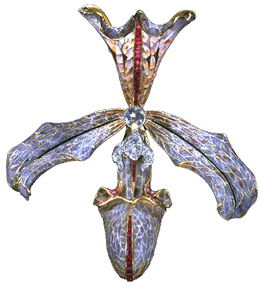
Hair ornament in the form of an orchid, made by Philippe Wolfers, Belgium, 1905-7. Museum no. M.11-1962. Image from the Victoria and Albert Museum website
I also must say, setting aside moral issues and countrys’ bruised egos, what is truly in the best interest of the objects themselves is for them to be left alone. Art and artifacts should be handled and moved as little as possible to avoid damage and the acceleration of deterioration. Professor Earenfight, who curates the Trout Gallery and teaches the museum studies course at Dickinson, likes to say that art and artifacts are like the elderly. They are set in their ways, used to their specific atmosphere, and the best thing for them is to disrupt their comfort as little as possible. The bottom line is, virtually all of the objects in London’s museums are priceless and definitely irreplaceable. The transportation of any of these objects across countries and continents is absolutely horrifying from an art conservation/curatorial point of view.
In any case, how great is it that we can get into all of these places for free? Sure, government subsidization lends itself to government censorship, but the fact that I can just wander in off the street, as I am, and walk right up to Jan van Eyck’s The Arnolfini Portrait, or Joseph Wright’s An Experiment on a Bird in the Air Pump, or the ship burial treasure from Sutton Hoo, or the Rosetta Stone and countless other treasures more than outweighs any negative aspects for me. London’s collections are among the finest in the world, and they are open to everyone. Now that’s beautiful.
Tags: 2010 Rachel
September 18th, 2010 · No Comments
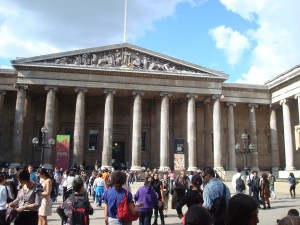
The museums of London seem to all fall around one dominant theme: imperialism. Seeing that this defined the British Empire for a majority of the last three centuries, it is no wonder that one can see its influence in each place one visits in London. Every museum either boasts the riches and plunders of the imperial era or makes some sort of comment on imperialism by what the curators chose and didn’t choose to include. As imperialism is, in my mind, the central idea around which all these museums exist, I’m going to take a look at each of the museums I have visited as reflections on the topic:
The British Museum: Many have already commented about the BM’s collection of artifacts and treasures from around the globe. It’s hard not to look at the mummies of ancient Egypt or the Elgin marbles without wondering just how exactly the BM got a hold of them. For its part, the museum seems to take delight in owning a collection that many would not consider rightfully theirs. On the “History of the World in 100 Objects,” I noted the quip the curator made about the “four languages” on the Rosetta Stone (as “Captured by the British Army” appears in English on the side of the artifact). While the BM could just ignore England’s imperial past, it seems to be content with making quips about where these objects came from. Essentially, the museum feels like a chance to show off the spoils of imperialism to rest of the world.

The Victoria and Albert Museum: This museum feels like a massive palace packed with valuables. In keeping with the British Museum, everything is thrown into areas based around vague “themes.” If you want to see jewelry, be prepared for a lot of rooms with a lot of randomly assorted riches. If you seek a certain historical artifact, you can probably find the right room based on the era and location of the piece, but after that you might have some problems as the rooms are randomly set up and gargantuan. Given the opulence of the collection, one cannot help but wonder how in the world the V&A wound up with all this stuff. The riches of imperialism are on full display at the V&A.
The Sir John Soane Museum: If the Victoria and Albert Museum feels like a massive palace packed with valuables obtained through imperialism, the Sir John Soane Museum IS a house packed with valuables obtained through imperialism. The place screams overkill, with walls of paintings that open up to more walls of paintings. I was particularly struck by the ivory chairs from India obtained during the eighteenth century: a very offsetting piece of the collection.
Natural History Museum: A few of us went through this museum after visiting the V&A, as the museum originated from the leftover collection at the V&A. While most of what one sees in the museum would not instantly recall British imperialism, some elements of the collection, like precious gems from South Africa, lead one to wonder just exactly how the museum got a hold of these pieces.
National Gallery: I really enjoyed this museum, but it is entirely Western European paintings. Given the Docklands Museum of London’s reference to the beauty of the arts in Africa before imperialism and slavery, why are none of these cultures, or those of the Middle East, represented?

National Portrait Gallery: I won’t go too much into this one, as several of my colleagues have already commented on the National Portrait Gallery’s imperialist nature. There is a stunning lack of racial or economic diversity in the collection, and I think a lot of that is a result of Britain’s imperialist past.
The Imperial War Museum: For a museum with the word “imperial” in the title, this museum actually had some of the least evidence of Britain’s imperial past of any of the places we visited. Only part of one wall was dedicated to all of the events surrounding the colonization of Africa, and I cannot recall any of the exhibits examining the struggles and fights for independence in any other former part of the British Empire. It is almost as if the curators wanted to sweep the entire history of British imperialism under the rug to focus on the glories of WWI and WWII. Based on the exhibits, one could easily come to conclusion that the Britain is embarrassed of its complete history. It was a cool museum, and I loved the section on British espionage (Who can’t love an exhibit that begins with James Bond clips?), but I found the museum incomplete because it ignored England’s imperial past.
The Cabinet War Rooms/Churchill Museum: My personal vote as the coolest museum in London, the Cabinet War Rooms show Britain near the end of the era of imperialism. Given the museum’s narrow focus, looking just at Churchill’s life and the struggle of the War Cabinet during the WWII Blitz, there was not much focus given to imperialism. One section of the Churchill Museum commented on the prime minister’s stance, early in his political career, in opposition to Indian independence. The part of the exhibit took a very apologetic tone, acknowledging Churchill’s mistake in taking such a position. Considering this museum is run in conjunction with the Imperial Museum, this part of the exhibit may provide an insight into the mind of the curators at that museum. Clearly, there is some sense of remorse on the part of the curators, evidenced by the Churchill Museum, for the British Empire’s actions, which could explain the lack of information about such events in the Imperial War Museum. Perhaps the curators are too ashamed to even broach the subject of British Imperialism.
Based on my observations, every museum I’ve seen in London is either indebted to imperialism due its bountiful collection of artifacts, or it tries to comment on the British Empire’s imperial past, typically by covering it up. Fifty years after the fall of imperialism, which is not that long ago, we still see its effects on the city of London.
Tags: 2010 Andrew
September 18th, 2010 · 1 Comment
As Kate Fox says in Watching the English, there is nothing the English dislike more than “making a fuss.” We see evidence of this in the English propensity for dirty looks and harrumphing in incidences of queue jumping, rather than directly confronting the social deviant, and apologizing incessantly when asking anyone in the service industry for the tiniest bit of service, among other things. Why, just moments ago, as I was asking Pat a question about the unfortunate current state of the blog site in a very hushed whisper, I was given the disgruntled throat clear by the elderly man sitting a couple seats to my left here in the Humanities Reading Room in the British Library.
At the British Museum, which attracts a great deal of tourists, you would think the employees would be more accustomed to handling the directness of foreigners, but you would be wrong. I’ve been amassing quite a collection of postcards since I’ve been here in London, and in my opinion the British Museum gift shops offer some of the most attractive options. They are, however, rather pricey at 60p a pop, so I was delighted when I saw a significant amount of postcards available through the 10 for 1 pound deal. I was decidedly less delighted when I noticed that a few of the postcards I had paid full price for were included in the discounted selection. So I sifted through the postcards I had purchased and fished out the ones that were on sale, so that I could take them back to the counter to return them. The saleswoman I spoke to said they didn’t do returns, I then explained the issue to her and she said there was nothing she could do about it, with the faux-polite “so sorry” of course. Being a student on a budget, I was not about to resign to paying 60p for something being sold for 10p so I requested to speak to a manager. The look of complete befuddlement and horror that spread across her face when I didn’t simply sigh and walk away with my over-priced postcards was fantastically English. The manager did arrive, and he corrected the problem, but not without displaying that he was obviously annoyed with me, telling me how complicated of a process he was about to undertake. As other customers queued up behind me at the till, he would sigh and say to them, exasperated “There’s another till ‘round the corner, it is going to be quite awhile.” The whole scene was like something out of a bad sitcom.
This experience was the complete opposite of what would have happened in America, where quality customer service is something many businesses and institutions pride themselves on. The phrase “the customer is always right” is replaced here by something like “even if the customer is unhappy, they’re unlikely to say anything about it, so, all’s well then, carry on.”
Tags: 2010 Rachel
September 15th, 2010 · 4 Comments
Last summer, when I visited the Acropolis Museum in Greece with my family, I did not know much about the controversy surrounding the Elgin marbles. It was probably the most remarkable museum that I have seen (including those in London), with a transparent glass floor at the bottom through which I could see the walls and streets of ancient Athens, revealed by an archeological dig. As I moved up through the museum, I saw countless beautiful statues and painted vases.
However, the most strongly featured exhibit was that on the top floor: the pediments, metopes, and frieze from the Parthenon. The collection was arranged in the exact size, shape and orientation of the Parthenon. Pieces from each category of ornamentation were conspicuously missing: full size models of them were interspersed with originals, mostly marked with plaques that said “BM,” for British museum and a few that named other museums worldwide as the thieves in question. One of Greece’s goals in building the new Acropolis Museum was to make its argument for the returning of the marbles, and the museum provided many not-so-subtle hints throughout its exhibitions that they should be returned, (such as an animated video in which the Elgin’s men, dressed in black, climb the Parthenon, pick up the statues and other artifacts, and walk away with them). Indeed, it would add to the experience of seeing statues built to adorn the Parthenon, to see the Parthenon itself through the enormous glass windows that surround the top gallery in the Acropolis Museum.
Fast forward to the Parthenon exhibit in the British museum. Here, there are no windows, and the only representation of the statues outside of the British museum’s collection is on a television screen in a side gallery. Like at the Acropolis museum, the Parthenon display is set up in the shape of the Parthenon itself, with the frieze and the metopes along the perimeter, and the statues from the pediments at either end. The statues (and especially the metopes, in which relief sculptures of battles with centaurs are carved), are individually beautifully crafted and some are in excellent condition, probably both because Elgin removed the very best of the statues from the site of the Parthenon, and because some damage has come to the collection in Greece since. Despite the high quality and obvious effort on the British Museum’s part to display the marbles so that visitors can picture what they would have looked like at the Parthenon, the effect is simply not the same.
The British Museum makes a pamphlet available to visitors that outlines their argument for keeping the marbles. It explains that Elgin took the Marbles with the full permission of the Ottoman authorities in Greece at the time. However, I see this as a case of interaction between two imperial forces, not between Elgin and “Greece” as the political and cultural entity that it is today. However legal the transaction was considered by the few individuals involved, it is likely that the results would have been different if Elgin had negotiated with someone with a higher stake in Greece’s cultural identity than a foreign, occupying power. The pamphlet also claims that the marbles should stay in London because they represent the cultural heritage of the entire western world, rather than only Greece. However, what claim does Britain have to being the ideal place to display everything that makes up the cultural history of all of Europe? If the debate centers around the well being of the statues themselves, it will go nowhere, because both the British Museum and the Acropolis Museum now have more than adequate facilities to preserve and display the Elgin Marbles.
This debate seems to have no logical conclusion. However, after experiencing seeing some of the statues (and through the plaster models, the entire set), at the location of their original home, I believe that Greece has a stronger cultural and historical claim. I realize that beginning to return artifacts would not be in the British museum’s best interest. However, returning some famous artifacts (and only to those countries that can care for them), would begin to send a message to the world that Britain is willing to address the wrongs committed during its imperialist past. It would probably also free up some exhibition space for some fantastic artifacts that are currently sitting in storage.
Tags: 2010 Emily · Uncategorized
September 9th, 2010 · 2 Comments
The British Museum is probably the best place in the world to get a historical narrative of the collective human race. This is probably because at the end of the 18th century when the museum was founded, the British Empire was at its peak and the government wanted to show its citizens items from the mysterious and exotic reaches of the empire. So throughout the century items from all over the world were shipped to London.
We can still see all of those items there today, and I have already spent many many hours exploring the museum’s diverse and extensive collection. I really enjoy the opportunity to listen to the podcasts (the history of the world in 100 items) on my journey through the museum. It was while listening to the podcast today about the Chinese Han Lacquer Cup that I began to notice something. Although the podcast references the items role in its specific country of origin, its primary goal is to show the listener where the piece fits in the history of the human race, as most items represent an idea or new technological skill.
This is a very globalizing force because all of the objects, whether Greek, Chinese, or Roman, are discussed in a way that illustrates them as items of human creation rather then objects of any specific empire or nation. In fact the museum tends to make the pieces culturally neutral as well by making most rooms look exactly the same. Each room has a glass case on each wall with perpendicular glass cases jutting out into the center of the room. In the middle occasionally there will be a larger item of more significance. As an avid attendee of American museums, I am spoiled by the Metropolitan Museum’s ability to change the layout and design of each room depending on what culture is on display.
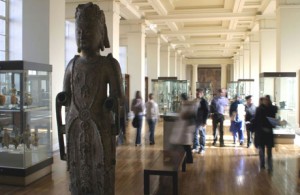
Perhaps this monotonous layout is designed to do what the podcast also attempts to do, make it one universal history unified in the museum by carbon copied rooms. This then gets to the debate brought up all over the world of whether or not those items even belong in the British Museum, but that is entirely too much to discuss in one blog.
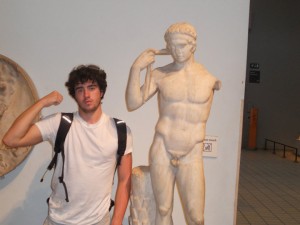
Tags: 2010 MatthewG · Museums
September 15th, 2009 · 1 Comment
I believe that this is a very important question that we must ask ourselves in order to understand museums and London in general. England is one (or maybe the only one, I am still trying to find out) of the countries in the world that has so many big museums which you can enter for free.
Apparently, museums in London used to be private, but in December 2001, the 15 main ones, such as the British, the Imperial War, the Tate Modern, were made public by Tony Blair’s administration. Many supporters of ‘New Labour’ considered this policy to be one of the major achievements of the party’s agenda. The government at the time was seeking to increase museum audience across the multicultural spectrum. They thought that by making the museums free of charge, they would receive not only a larger audience, but a more diverse one. Why museums? As I mentioned in an earlier post, museums have proven to articulate the ideology of the state and work as institutions that reclaim the national identity, much needed to rule a country.
After some time, research showed that, while making the museums public had increased tourism, they did not attract new audiences, but rather more frequent visits by the same crowd as before (mostly white and upper middle class art lovers).
This makes me wonder why there are so many people in London who might have never attended any of these museums and why not? They’re free! But giving further thought to the matter, I realized that the museum is not going to receive more Africa-descended people by exhibiting African masks. The same way Latin American people in London are probably not going to go to the British Museum’s exhibition of Moctezuma. The Victoria&Albert Museum’s fashion exhibit attracts young designers, but that is probably the most “exotic” audience they have.
What is access to culture then? How do we define it? It is certainly not only a matter of financial access, as we can see. I think that, again, it has to do with how people are located in the structure, and how much cultural capital they have. Once more, it might also be strongly related to being able to afford the time to visit a museum.
Tags: Azul
September 15th, 2009 · 1 Comment
Today I visited the British Museum. Yes, I know, I am probably the LAST person to go there. But to be honest, I was really putting it off. Now that may seem strange to you, since if you’ve been keeping up with my blog, you know I ADORE museums. Yet, for some reason the idea of museum that I could spend my entire life trying to see the entire collection of, just didn’t get me going. I was told it was a history museum, told it was vast, told it was cool. But still. I’m not a history museum fan and I guess the past month has really museumed me out. With all that being said, I LOVED it.
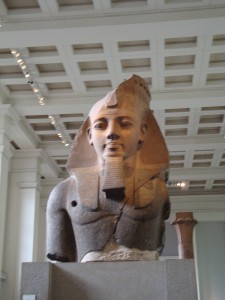
Egypt Wing of museum
And I loved it for several different reasons. The first and less detailed reason was what I faced when I first ventured into a gallery. It was the Egypt wing. I am not a fan. I don’t dislike all the mummy cases and pharaoh busts, they just aren’t really my thing. But back in Brooklyn, at the Brooklyn Museum of Art, the museum that I have been going to since my stroller days, the first place where I took an art class, and where I spent my summer interning, there is a HUGE Egypt wing. And suddenly, there I was, middle of the British Museum Egypt wing, in London, in England, in a FOREIGN COUNTRY, and home, all at once. I didn’t stay in the wing long, but the small boost of Brooklyn love I got from the wing was just what I needed before we embark on our new adventure to Norwich.
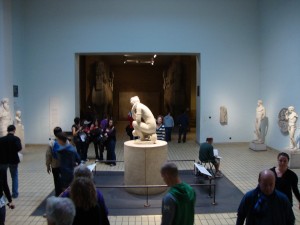
The Greece Wing of the British Museum
Another reason I loved it was on the pure artistic level. As a museum lover and art minor, walking into the museum facing the Greek statues and really analyzing them art historically was so amazing. I really took my time looking a few pieces rather than trying to see everything in the overwhelming collection. I noted the realism in the Hellenistic section of the Greece wing. I got right up close to the statues and looked at the small details, the way the flesh was rolled where the body curved, or the controposto (weight distribution), or the way the head resting on the elbow really had the right weight. Even the way the lighting on the marble gave it a warm yellow hue, almost like the warmth of skin and the human body, making the figures see that much more alive and real. Often I found myself inching closer and closer to a figure wanting to touch the marble, wanting to feel the coolness of it just to remind myself it was not warm flesh.
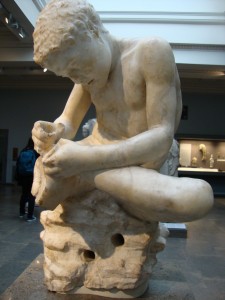
There was on statue of a small boy, Marble statues of a boy, the so-called ‘spinaro.’ This one was one of the most touching. The boy was pulling a torn out of his foot. And the expression on his face was just right, to show a little boy’s concentration and fascination. Having a little brother myself may have biased me towards this sculpture over others, and maybe it was just another thing in the museum that made me feel at home. But really, even the way to boy was crouched over suited the narrative of the piece.
On another note, the British Museum has so many connections to our course here in London. Aside from its fame Reading Room that relates to the literary history of this area, there is always the basic collection as a representation of all the different communities and cultures present. With a wing from almost every continent, the British Museum has very few things that could be considered wholly “British.” But at the same time, isn’t that really what we have learned here this past month, that NOTHING really is WHOLLY British? I think it is. In essence, the British museum encompasses our whole class and our final conclusion that there is no British identity. That there are only many pieces from many different elements of people’s lives that use to help with their personal identification.
Tags: Megan · Museums
September 15th, 2009 · No Comments
-
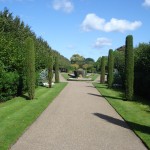
-
Regents Park
-
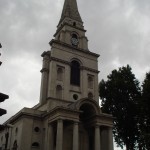
-
Christ’s Church
-
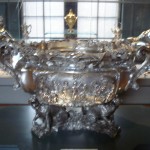
-
The Silver Exhibit in the V&A
-

-
Having a Good Time at the Fitzroy
Like many of my classmates I decided it would be worthwhile to summarize all of my discoveries this month in London. During this post I will focus on six main themes found within London: Parks, Churches, Pubs, Other Religious Institutions, Theatre and Museums.
Parks
Each park that I visited had its own distinct characteristics that separated it from any other. Green Park was the first I visited and after perusing a few others, I realized there was nothing that exciting about it. Located right across from Buckingham Palace, Green Park certainly provides a good place to go and take a break from the busy atmosphere of the area. Besides this however there is not much going on and I would recommend that potential park goers walk the extra distance over to St. James Park.
In addition to the large number of waterfowl heckling people for food which offers consistent entertainment St. James offers some picturesque flower beds throughout and various monuments along the way. It has the relaxing atmosphere of Green Park with a bit more excitement sprinkled in.
Regents Park offers a completely different feel from Green or St. James. Located in a separate area of London, Regents Park has a history of being used by a higher end crowd. I could tell this immediately from the feel of the park. The decorative shrubbery and elegant architecture throughout gave me a feeling that Regents is not as well used as other parks.
Since I was one of the members of the Parks group that gave a walking tour of Hyde Park and Kensington Gardens I could go into a lot more detail about these two green spaces but I will choose not to in an effort to be concise. In summary Hyde Park is the largest green space in London and is often used for larger events such as concerts, festivals etc. It also contains a large number of monuments throughout including the 7/7 memorial and the Diana Memorial Fountain. Kensington Gardens is home to a variety of key monuments but is not as well trodden as Hyde. Overall it makes for a quieter atmosphere, more conducive fo reading or “snogging”.
Regents Park were my two favorite green spaces in London. Regents, is both beautiful, and extremely large and I continually felt the need to go back and explore. Kensington Gardens appealed to me in that it was quainter than Hyde Park but contained a like amount of history and monuments throughout. Although I would be content spending a length of time in any London green space Regents and Kensington would be my top choices.
Theatre
Overall I enjoyed going to the theatre on so many occasions. What better place to do so than in London after all? Here I will discuss my favorite performances and theatre venues.
All in all I enjoyed all but two of the performances we saw. The two Shakespeare productions at The Globe Theatre were fantastic. Although I did not particularly enjoy reading Troilus and Cressida it made a huge difference to be there so close to the actors. The fantastic drum chorus at the end really sealed the deal. As You Like It was probably my favorite show I saw here in London. Although it is one of Shakespeare’s simpler plays the actors really made it jump off the page. Being down it the pit was fantastic because of all the ad-libbing and constant interaction with the crowd. I even felt traces of Touchstone’s saliva on my arm at one point.
The other Shakespeare performance I saw, All’s Well That Ends Well, was lackluster. Although the Olivier was my favorite performing venue (this is what an auditorium style theatre should be like…why can’t Dickinson have something like this?) the play itself was odd and ended on an abrupt and odd note.
The other play we saw at the National Theatre, The Pitmen Painters, was fantastic. Although I was dozing a bit because of the Benadryl I took right before the show, the actors kept my attention and I appreciated that the play was based off of a true story.
Easily the oddest play we saw was Arcadia. An extremely intelligent performance the play juxtaposed two different periods in time and created a singular storyline in which the plot was based. Overall it was an entertaining performance that made me think early and often.
Finally there was Blood Brothers. The lone musical I saw produced feelings of disbelief, anguish and held back laughter. The ridiculous 80’s sound track and creepy narrator just didn’t do it for me. I think it’s safe to say that I was not the only one from Humanities 309 who was a bit surprised to see just about everyone in the audience give it a standing ovation.
I had a very positive experience with the theatre here. I would go back to the globe again and again. I loved being that close to the action. I would also enjoy seeing another show in the Olivier. There really is so much to choose from here. It’s simply a matter of figuring out your tastes and saving your money so you can see a lot of performances.
Churches
From Westminster Abbey to St. Paul’s Cathedral we saw most of the major churches/cathedrals during our month in London. St. Paul’s was easily my favorite. From the fantastic crypt to the hundreds of stairs up to the tower it had so much to offer in the way of history and mystique. Westminster Abbey fascinated me primarily because of all the literary figures that had been buried inside as well as the room that was dedicated to “The Order of the Bath”. Other churches that I really enjoyed taking a look at were: “St. Martin in the Fields” which sits just outside Trafalgar Square and Nicholas Hawkesmoore’s “Christ’s Church” which is located in very close proximity to Brick Lane.
Other Religious Institutions
Overall the Sikh Gurdwara was my favorite place that we visited. I appreciated the simplicity of the religious doctrine as well as the conviction and honesty with which our tour guide, Mr. Singh spoke. The morning was capped off with a fantastic sit down meal together in which everyone was served the same food and drink.
I had different feelings about the Hindu Mandir. It was clear to me from the very beginning that the Hindu religion is not nearly as modest as Sikhism nor are they trying to be. From the extremely decorative prayer room, to the museum located right in the center of the Mandir I never felt particularly comfortable inside.
The only religious institution I wish we had gotten a chance to visit is a Mosque. I had been to one many years ago but I did not remember a whole lot from my experience. I wonder how much more lively the East End, and all parts of London would be if Ramadan were not taking place during our time here.
Museums
I could go on and on about museums so I will attempt to stay as concise as possible.
The British Museum was massive, convenient since it was so close to the Arran House but a little one dimensional at times. One of my favorite exhibits at the British Museum was a special exhibit on Living and Dying that drew information from all different time periods and cultures.
The National Gallery was fantastic. Although I have a hard time appreciating some visual art the gallery kept my attention for a number of hours. Seeing so many famous works of art was phenomenal.
The Tate Modern was my least favorite museum here. Although I am trying I have a hard time understanding modern art. After about 45 minutes in this museum it ended up being too much for me.
The Cabinet War Rooms/Churchill Museum were two of my favorites. The realization that I was standing in one of the most important places in World War II history was unbelievable. The War Rooms felt so authentic. I really felt as though I had been taken back in time to the 1940’s while inside.
The Victoria and Albert was easily my favorite museum in London. There was so much variety inside and so much to see. I could have easily spent a few days inside. Two of my favorite exhibits were the silver and jewelry exhibits. I’m not sure what this says about me as a person but I found it unbelievable that individuals could even own such treasures. I also enjoyed the laid back atmosphere of the V&A staff. At most of the other museums I visited I felt like I was doing them a disservice simply by being there. Although I understand that taking pictures of an object in a museum doesn’t do it justice I like to be able to have the option of doing so.
The Sir John Soane museum interested me but it wasn’t really my cup of tea in the end. It also had a stuffy atmosphere to it that I didn’t really appreciate.
One thing I can draw from my experience at museums here is that each and every one has something that distinguishes it. With so many museums I thought that it would be impossible to avoid some overlap but I never really felt that. Cheers to London and its museums.
Pubs
Finally we have pubs. What would London be without it’s public houses? In some cases pubs are the true museums of London, designating what an area was like in the past and what type of clientele it attracted. During my month here I had a chance to visit a few pubs and get a general sense of what some possible differences could be. It is clear to me that each pub brings something different and unique to the table. The Marlborough Arms was convenient being so close to the Arran House and was a great place to enjoy a pint over a meal with friends. The Court was conducive to socializing in a different way. The music was louder, the people louder and the drinks cheaper. Other places I visited offered other things that made them stand out as well. One thing that i’ve learned about pubs is that it’s hard for one to please everyone. Since everyone has different tastes and desires when it comes to pubs you are better off going to one with a small cohesive group.
To conclude this novel I would just like to say that I think we saw a lot of different faces of London this month. I realize there is much more to see here but between walking tours throughout the city, trips to major monuments and museums and individual exploration I have learned a ton about London, it’s history and where it is going. I look forward to more London explorations in the future but for now, ON TO NORWICH!
Tags: Churches and Cathedrals · Henry · Pubs · Theatre
September 14th, 2009 · No Comments
And now, the thrilling conclusion to the epic saga that is Andrew’s London museum experience!
The British Museum
Because the British Museum is so darned enormous, I decided to stay within the comforting walls of the ancient Greece and Egypt exhibitions. Greece was fascination. As one of the few students in my major who actually enjoyed ancient philosophy, it was oh so cool to see the world in which some of the most important thinkers in history lived within. Part of the Parthenon was on display. The Parthenon! This building is the most significant symbol of democracy in existence. Throughout time, different civilizations used the structure for their own purposes. In the 6th Century, it was a church. During the Ottoman occupation, it was a mosque. It was unearthed by Lord Elgin in the early 1800s, and now resides, in part, in the British museum.
There is a major debate going on now about whether the Parthenon remains should remain in the UK or be transported back to Greece, its original location, where another segment of the structure is preserved and on display. I believe that it belongs back in Athens. After all, a puzzle missing half the pieces is much less decipherable than one only a quarter. The closer archeologists and historians can come to complete recreation of the Parthenon, the better. So get it out of London and back to Greece!
Egypt was as expected. Some statues. Some mosaic. Some mummies. I saw Cleopatra, which was cool. I’ve seen Egyptology exhibits in the Smithsonian and Egyptian art in the Met in New York. The British Museum didn’t offer me anything new and exciting, so I don’t have much else to say on the topic.
The National Gallery
As The Pitmen Painters made clear, art is in the eye of the beholder, and sometimes the beholder’s eye just isn’t sharp or refined enough. When I look at the countless portraits, landscapes, and still lifes I don’t have the same emotional response connoisseurs of the arts seem to undergo. I cannot seem to get past the raw aesthetics of most paintings and appreciate their apparent value.
Take Van Gogh’s seminal Sunflowers, for instance. This work is so loved, so well known, and so damned valuable and I just don’t understand why. In fact, Van Gogh once said that this particular painting is his crowning achievement. To me, the barbarian, “Sunflowers” is a beautiful rendering of a vase full of sunflowers against a black background. Why on Earth a Japanese man paid almost $40,000,000 for a version of the painting is beyond me. Maybe one day I will have a Pitmen Painters-esque revelation and understand, but until that day I remain in the dark.

http://webartgallery.org/files/origopage/images/vangogh060.preview.JPG
That isn’t to say there aren’t any paintings that did stir me. Cézanne’s An Old Woman With a Rosary is a portrait of just that, an elderly woman clutching what seems to be a broken rosary. To me, the work encapsulates all the bleakness and sorrow of the world within her dead, black eyes. It seems transport you into the mind of the woman and forces the viewer to feel her pain. She knows that her life is almost at an end, so she desperately hangs on to her religion for salvation. Perhaps she has lived a life of sin and is afraid of what awaits her beyond the grave. Maybe she is trying to force herself to accept Jesus and repent for her sins in order to avoid damnation. Cézanne’s rendering of the woman’s eyes affected me most – a sea of darkness in which no one can escape. There is no light or color, only horror, pain, and sadness.
Ok, so maybe I can appreciate painting. Thanks, Mr. Cézanne.

http://arttoheartweb.com/images/Cezanne1.jpg
Tate Modern
Whew. Just when I was starting to think, hey, maybe I can appreciate and understand the visual arts on a deeper level, modern art punched me in the gut. I’ve never taken an art history or appreciation class and simply don’t know what to look for. When I see something by an artist by, say, Cy Twombly, all I see is colors and shapes on a background. Considering my laudable capacity for music appreciation, struggling so much in an art gallery is remarkably frustrating. Paul McCarthy’s sexually explicit video art strikes me as a petty cry for attention through shock value.

http://www.tate.org.uk/collection/P/P07/P07581_9.jpg
That said, I have always had an affinity for the surreal and absurd in literature, film, and especially philosophy. The Tate Modern has an excellent surrealism section showcasing artists like Salvador Dalí and Marcel Duchamp. I found myself losing myself in the strange worlds of the artists’ creation. Dalí’s Metamorphosis of Narcissus pervaded my mind with a breed of thought only accessible through a surrealist lens. And then you have something like the Lobster Telephone that you can’t help but laugh at.

http://www.tate.org.uk/collection/T/T02/T02343_9.jpg

http://www.tate.org.uk/collection/T/T03/T03257_9.jpg
While the National Gallery was too concrete, much of the Tate Modern was just too abstract. Surrealism and Cézanne aside, my current capability to appreciate the visual arts is lacking. Art history majors, help me!
To conclude, I leave you with a photograph of a Paul McCarthy work that actually is safe for work, barely. I present to you Santa Clause with a Buttplug.

http://upload.wikimedia.org/wikipedia/en/c/cb/Tierecke_mccarthy.jpg
Tags: Andrew B




















